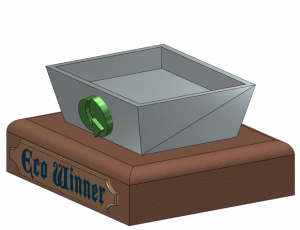Product Design aims to enable students to develop their thinking skills and their practical skills, through problem solving in a range of materials. They learn to use a wide range of hand and machine tools and produce quality products to be proud of.
This subject involves a distinctive creative process that combines intellectual with practical skills through purposeful activities. Students will use a range of communication skills, including: verbal, graphical and modelling skills, to help their thinking and ability to take action in the process of designing and creating. Students learn through both theoretical and practical activity.
Product Design provides excellent opportunities for teamwork and these subjects provide opportunities for students to engage in activities that are challenging, relevant and motivating, giving students enjoyment, satisfaction and a sense of purpose, enabling them to feel they can play a constructive role in a fast paced, changing technological society.

At KS3, Year 7 and 8 students partake in a half termly cycle where they explore a range of creative subjects. During the cycle, students will cook a range of dishes in food technology, explore sewing, tie dye, and surface pattern techniques, develop making skills with using a range of materials to model and prototype 3D products. These subjects have been designed to cater for a range of learning styles, offering a more practical exploration of materials and ideas. Students will develop outcomes inspired by designers from a range of specialisms.

Our curriculum has been planned and organised in a way that creates consistency across all creative specialisms. Topics in art will link to topics being taught in 3D Art and Photography. Assessments have been planned to reflect this also. As a team, we have decided that it would be more effective for the four GCSE assessment objectives to become the framework across all creative subject areas, topics and Key Stages. For example; Y8 students learn about buildings and architecture in art. They study the work of Gaudi and learn to develop their fine art drawing and painting skills. In 3D design, they will look at the work of structural and model building artists, developing a more in-depth understanding of how to construct buildings using cardboard, acrylic and foam. Students are assessed on the same four objectives but these are applied to the media, process and development of ideas as well as the final outcomes. This approach ensures students have a clear understanding of the assessment objectives; as staff we can model this and ensure students are prepared for when they choose their GCSE options.
At GCSE level students will develop their skills and understanding of a range of material, techniques and processes to plan, design and make a product that fulfils a contextual challenge set by the exam board. The course comprises of 50% controlled assessment in the form of coursework, sketchbook, portfolio and practical outcome and 50% Exam, which is a formal written exam paper set by the exam board.
Product Design allows students to develop creative ideas and refine their work as it progresses, experimenting and evaluating to produce the best possible outcomes. Students will present a personal response to a range of exciting project briefs.
All practical projects, subjects and topics have been designed to offer experience and development of a range of life skills we would like our students to have. As a department, we ensure all students feel cared for, are safe and have a sense of belonging. We encourage individuality and independence, planning projects that give students the chance to express themselves. We teach students the importance of health and safety with a range of tools, equipment, preparation of foods and personal safety.
Product Design Department
Mrs J Steele – Subject teacher
Miss A Booton – Subject Teacher and Progress Leader for Year 9
Miss B Peake – Lead Teacher for Engineering



